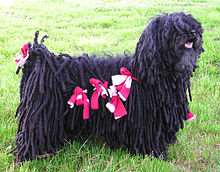Puli

Puli
|
||||||||||||||||||||||||||
| Other names | Hungarian Puli | |||||||||||||||||||||||||
|---|---|---|---|---|---|---|---|---|---|---|---|---|---|---|---|---|---|---|---|---|---|---|---|---|---|---|
| Origin | Hungary | |||||||||||||||||||||||||
|
||||||||||||||||||||||||||
| Domestic dog (Canis lupus familiaris) | ||||||||||||||||||||||||||
| Classification / standards | |||
|---|---|---|---|
| FCI | Group 1, Section 1 Sheepdogs #55 | standard | |
| AKC | Herding | standard | |
| ANKC | Group 5 (Working) | standard | |
| CKC | Group 7 - Herding Dogs | standard | |
| KC (UK) | Pastoral | standard | |
| NZKC | Working | standard | |
| UKC | Herding Dog Breeds | standard | |
The Puli is a small-medium breed of Hungarian herding and livestock guarding dog known for its long, corded coat. The tight curls of the coat appear similar to dreadlocks. A similar-looking, but much larger breed – also Hungarian – is the Komondor. The term used for a group of Puli is Pulik.
The Puli is a solid-colored dog that is usually black. Other less common coat colors are white, gray, or cream (off-white or fakó in Hungarian). A variety of the cream-coated dogs have black masks. The white Pulis are not albino, nor do they have blue eyes. They commonly have dark pigment, black pads, black noses and black pigment inside the mouth. The white gene is recessive to the pure black gene. The breed standard is for females about 16.5 inches (42 cm) at the withers, and 17 inches for males. Females weigh 23-25 pounds, males slightly more. The coat of some Puli dogs can be different, thinner or thicker cords, either flat or round, depending on the texture of the coat and the balance of undercoat to outer coat.
The coat is the result of a controlled matting process. Thin, rope-like corded coats are desired, and the grooming should control the coat towards the forming of thinner ropes. The Puli's coat needs considerable grooming to keep its cords clean, neat, and attractive. With age the coat can become quite long, even reaching the ground. Alternatively, the coat can be trimmed short regularly for easy maintenance, although the corded coat is what attracts many people to the breed. Contrary to some beliefs, the coat of a healthy puli will grow out again after trimming. This breed has little to no shedding.
The Puli is an intelligent and active dog. It needs obedience training while still young. If a Puli gets enough exercise it can live in the city, but Pulis do best when not kept as indoor pets in a small living space. Pulis kept indoors need a lot of exercise to use up their energy, or they can become either shy or overactive. They need to get the kind of exercise they were created for. A Puli without enough exercise can become mischievous and cause trouble. The right kind of exercise includes running, biking, hiking, jogging and field work; not just a walk around the corner. Pulis are best kept in a house with a garden. Cozy and very friendly, especially towards children, but sensitive and prone to resentment.
...
Wikipedia
